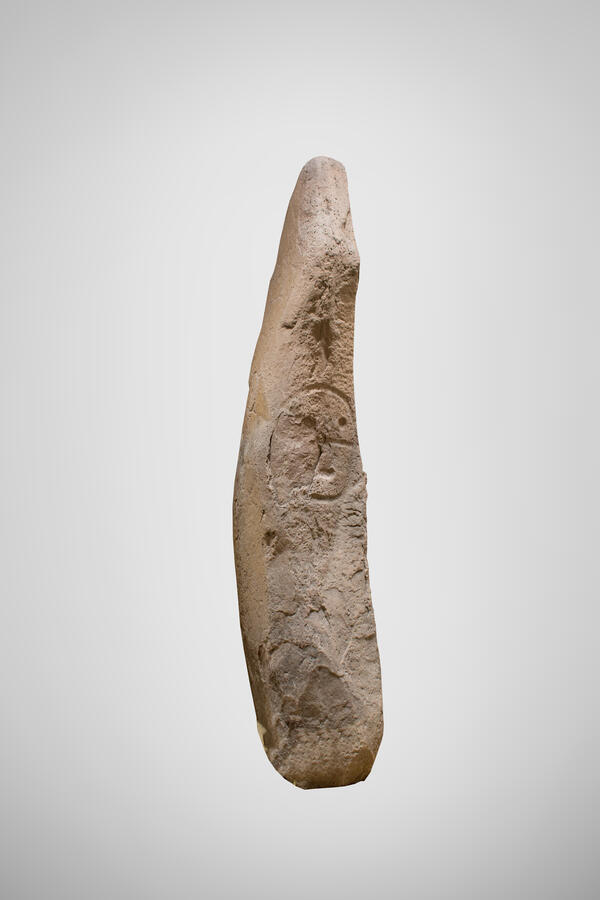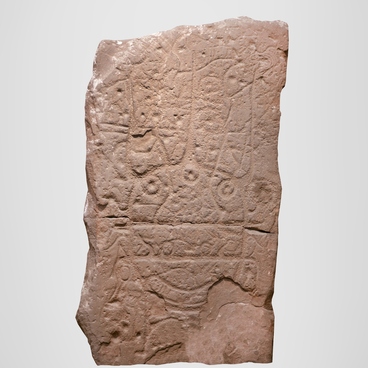In 1956, the archaeologist of the Khakass Regional Museum of Local History, Albert Lipsky, discovered a stone stela more than 2 meters high in the lower reaches of the Tyoya River in the Askizsky district of Khakassia. It was dug upside down into the fence of the Tagar mound, from its western side. Scientists have established that it was made in the late 3rd — early 2nd millennium BC from red sandstone, which was formed in the Devonian period — from 358 to 419 million years ago.
The stela belongs to the culture of the Okunevites — tribes that inhabited the territory of modern Khakassia at the beginning of the Bronze Age. On stone pillars and slabs, they carved images of deities, spirits, and solar symbols.
In the middle part of the stela, the so-called face is carved —— a schematic representation of a human face. Its forehead and chin are highlighted with a clear outline. There is a horizontal line between the eyes and the mouth, at the level of the cheekbones. The mask has no nose, the eyes are marked with holes, and the mouth has the shape of a wide oval groove. A third of the image on the left side has not survived to this day.
On the left side of the stela, two solar signs are engraved one above the other. One of them looks like a circle with four triangular rays on the sides, the other one looks like the first one, but has a shallow hole in the center. The image of a horse can be seen under the lower sign, but it was probably put on the statue later — between the 8th and 3rd centuries BC, in the Tagar period. Perhaps it was then that the stela became part of the mound fence.
Albert Lipsky assumed that the mask on this stone statue depicts tag eezi — the spirit who was considered the master of the mountains, taiga and all the animals that lived there. According to ancient Khakass beliefs, tag eezi lived in the so-called Middle World — that is, among people. The upper world, according to such myths, was inhabited by good gods and masters of the elements, and evil spirits lived in the lower world, who sought to harm a person in every possible way. It was believed that tag eezi treat people kindly, can give longevity, healthy livestock and a happy life. However, legends have survived in which the spirits punished those who disrespected them or harmed nature.
The stela belongs to the culture of the Okunevites — tribes that inhabited the territory of modern Khakassia at the beginning of the Bronze Age. On stone pillars and slabs, they carved images of deities, spirits, and solar symbols.
In the middle part of the stela, the so-called face is carved —— a schematic representation of a human face. Its forehead and chin are highlighted with a clear outline. There is a horizontal line between the eyes and the mouth, at the level of the cheekbones. The mask has no nose, the eyes are marked with holes, and the mouth has the shape of a wide oval groove. A third of the image on the left side has not survived to this day.
On the left side of the stela, two solar signs are engraved one above the other. One of them looks like a circle with four triangular rays on the sides, the other one looks like the first one, but has a shallow hole in the center. The image of a horse can be seen under the lower sign, but it was probably put on the statue later — between the 8th and 3rd centuries BC, in the Tagar period. Perhaps it was then that the stela became part of the mound fence.
Albert Lipsky assumed that the mask on this stone statue depicts tag eezi — the spirit who was considered the master of the mountains, taiga and all the animals that lived there. According to ancient Khakass beliefs, tag eezi lived in the so-called Middle World — that is, among people. The upper world, according to such myths, was inhabited by good gods and masters of the elements, and evil spirits lived in the lower world, who sought to harm a person in every possible way. It was believed that tag eezi treat people kindly, can give longevity, healthy livestock and a happy life. However, legends have survived in which the spirits punished those who disrespected them or harmed nature.



